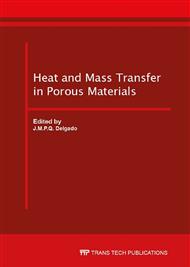[1]
E. Barreira, V.P. de Freitas, Experimental study of the hygrothermal behaviour of External Thermal Insulation Composite Systems (ETICS), Build. Envirom., 63 (2013) 31-39.
DOI: 10.1016/j.buildenv.2013.02.001
Google Scholar
[2]
H.A. Iglesias, J. Chirife, Handbook of food isotherms, Academic Press, New York, U.S.A., (1983).
Google Scholar
[3]
D. Marinos-Kouris, Z.B. Maroulis, C.T. Kirannoudis, Computer simulation of industrial dryers, Dry. Technol., 18 (1996) 971-1010.
DOI: 10.1080/07373939608917137
Google Scholar
[4]
Z.B. Maroulis, G.D. Saravacos, Food process design, Marcel Dekker, New York, USA, (2003).
Google Scholar
[5]
L. Derdour, H. Desmorieux, J. Andrieu, A contribution to the characteristic drying curve concept: Application to the drying of plaster, Dry. Tech., 18 (2000) 237-260.
DOI: 10.1080/07373930008917702
Google Scholar
[6]
V.P. de Freitas, V. Abrantes, P. Crausse, Moisture migration in building walls – Analysis of the interface phenomena, Build. Environm., 31 (1996) 99-108.
DOI: 10.1016/0360-1323(95)00027-5
Google Scholar
[7]
M. Krus, A. Holm, Simple methods to approximate the liquid transport coefficients describing the absorption and drying process, Proc. 5th Symp. Building Physics in the Nordic Countries, Gothenburg, Sweden, pp.241-248, (1999).
Google Scholar
[8]
T. Bednar, Approximation of liquid moisture transport coefficient of porous building materials by suction and drying experiments. Demands on determination of drying curve, Proc. 6th Symposium on Building Physics in the Nordic Countries, pp.493-500, Trondheim, Norway, (2002).
Google Scholar
[9]
M. Karoglou, A. Moropoulou, Z.B. Maroulis, M.K. Krokida, Drying kinetics of some building materials, Dry. Tech., 23 (2005) 305-315.
DOI: 10.1081/drt-200047926
Google Scholar
[10]
J.M.P.Q. Delgado, N.M.M. Ramos, V.P. de Freitas, Can moisture buffer performance be estimated from sorption kinetics?, J. Build. Phys., 29 (2006) 281-299.
DOI: 10.1177/1744259106062568
Google Scholar
[11]
C.L. Hii, C.L. Law, M. Cloke, Modelling of Thin Layer Drying Kinetics of Cocoa Beans During Artificial and Natural Drying, J. Eng. Sci. Technol., 3 (2008) 1-10.
Google Scholar
[12]
A. Kuitche, M. Edoun, G. Takamte, Influence of Pre-Treatment on Drying on the Drying Kinetic of a Local Okro (Hibiscus Ersculentus) Variety, World J. Dairy Food Sci., 2 (2007) 83-88.
Google Scholar
[13]
C.Y. Wang, R.P. Singh, A Single Layer Drying Equation for RoughRice, ASAE Press, St. Joseph, USA, (1978).
Google Scholar
[14]
N.A. Akgun, I. Doymaz, (2005) Modelling of olive cake thin-layer drying process, J. Food Eng., 68 (2005) 445-461.
DOI: 10.1016/j.jfoodeng.2004.06.023
Google Scholar
[15]
E.K. Akpinar, Determination of suitable thin layer drying curve model for some vegetables and fruits, J. Food Eng., 73 (2006) 75-84.
DOI: 10.1016/j.jfoodeng.2005.01.007
Google Scholar
[16]
S.J. Babalis, E. Papanicolaou, N. Kyriakis, V. G Belessiotis, Evaluation of thin-layer drying models for describing drying kinetics of figs (Ficus carica), J. Food Eng., 75 (2006) 205–214.
DOI: 10.1016/j.jfoodeng.2005.04.008
Google Scholar
[17]
I.T. Toğrul, D. Pehlivan, Modelling of drying kinetics of single apricot, J. Food Eng., 58 (2003) 23-32.
DOI: 10.1016/s0260-8774(02)00329-1
Google Scholar
[18]
T.L. Thompson, R.M. Peart, G.H. Foster, Mathematical Simulation of Corn Drying A New Model, Trans. ASAE, 11 (1968) 582-586.
DOI: 10.13031/2013.39473
Google Scholar
[19]
M.R. Paulsen, T.L. Thompson, Drying endysus of grain sorghum, Trans. ASAE, 16 (1973) 537–540.
Google Scholar
[20]
M. Kashaninejad, A. Mortazavi, A. Safekordi, L.G. Tabil, Thin-layer drying characteristics and modelling of pistachio nuts, J. Food Eng., 78 (2007) 98-108.
DOI: 10.1016/j.jfoodeng.2005.09.007
Google Scholar
[21]
D.S. Sogi, U.S. Shivhare, S.K. Garg, S.A. Bawa, Water sorption isotherms and drying characteristics of tomato seeds, Biosyst. Eng., 84 (2003) 297-301.
DOI: 10.1016/s1537-5110(02)00275-1
Google Scholar
[22]
I. Ceylan, M. Aktas, H. Dogan, Mathematical modelling of drying characteristics of tropical fruits, Appl. Therm. Eng., 27 (2007) 1931-(1936).
Google Scholar
[23]
P.C. Panchariya, D. Popovic, A.L. Sharma, Thin-Layer Modelling of Black Tea Drying Process, J. Food Eng., 52 (2002) 349-57.
DOI: 10.1016/s0260-8774(01)00126-1
Google Scholar
[24]
R. Guiné, Analysis of the Drying Kinetics of S. Bartolomeu Pears for Different Drying Systems, PhD Thesis, Porto, Portugal, (2010).
Google Scholar
[25]
A. Taheri-Garavand, S. Rafiee, A. Keyhani, Mathematical Modelling of Layer Drying Kinetics of Tomato Influence of Air Dryer Conditions, Int. Trans. J. Eng. Manag. Appl. Sci. Technol., 2 (2011) 147-160.
Google Scholar
[26]
A. Ayensu, Dehydration of food crops using a solar dryer with convective heat flow, Solar Energy, 59 (1997) 121–126.
DOI: 10.1016/s0038-092x(96)00130-2
Google Scholar
[27]
R.C. Hansen, H.M. Keener, H.N. ElSohly, Thin-layer drying of cultivated taxus clippings, Trans. ASAE, 36 (1993) 1873–1877.
DOI: 10.13031/2013.28536
Google Scholar
[28]
J.V. Carbonell, F. Pinaga, V. Yusa, J.L. Pena, Dehydration of paprika and kinetics of colour degradation, J. Food Eng., 5 (1986) 179–193.
Google Scholar
[29]
V.T. Karathanos, Determination of water content of dried fruits by drying kinetics, J. Food Eng., 39 (1999) 337–344.
DOI: 10.1016/s0260-8774(98)00132-0
Google Scholar
[30]
O. Yaldiz, C. Ertekyn, Thin layer solar drying of some vegetables, Dryi. Technol., 19 (2001) 583-597.
Google Scholar
[31]
A. Kaya, O. Aydın, C. Demirtas, Drying Kinetics of Red Delicious Apple, Biosyst. Eng., 96 (2007) 517-524.
DOI: 10.1016/j.biosystemseng.2006.12.009
Google Scholar
[32]
J. Crank, The mathematics of diffusion, Second edition, Oxford University Press, United Kingdom, (1975).
Google Scholar


